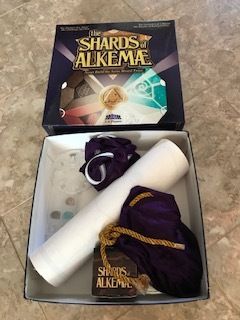|
Advertisement
|
Shards of Alkemae

DescriptionShards of Alkemae may be played at three different levels, Novice, Apprentice, and Master. Game play remains essentially the same, but rules change from level to level. Regardless of level, players take turns laying down tiles to form the game board and move their game pieces about the board, trying to lay claim to regions worth the most points. The tiles (based on Penrose tiles) are of two types, kites and darts, which fit together to form a quasi-symmetric tessellation. A gold kite serves as the centerpiece and entryway for game pieces to move onto the playing area. Sixty kites and thirty-six darts are placed into separate bags, from which players draw blindly to begin their turns. Represented on each tile face is one of the following elements: earth, air, fire, or water. Additionally, there are twelve “wild-card” kites, which can serve as any of the four elements. Each player begins the game by drawing a tile from each bag and setting them in front of the player, one face up, one face down. On a turn, a player draws a tile from either bag and sets it down adjacent to the tiles already placed. A player may place the tile drawn, either tile in front of that player, or any “face-up” tile from another player. Judicious tile placement usually results in the formation of one of seven geometric patterns, called “shards”, which are named: ace, deuce, jack, queen, king, star, or sun. Any player completing one of these shards receives a token representing the shard formed. After placing a tile to form a shard, the player then advances one of four playing pieces (in the shapes of chemical glassware) onto the game board. As players place more tiles, the game board grows, and like-colored regions of each of the elements form. Players accumulate shards which may be turned in for gold “transmuting stones”, which are then used by a player to lay claim to a region (any contiguous grouping of like-colored tiles). Players try to move their game pieces into regions and lay claim to one region of each element before the other players. The game ends when one player claims one region of each element, or all the tiles have been placed on the board. Two key components of a winning strategy are prediction (determining where wealthy regions will form) and risk/benefit analysis (choosing whether to claim smaller regions early or wait until they grow into more prosperous ones as the board grows). Game DiscussionsAdd CommentYou need to be logged in to comment. Insert Bullet List Please enter at least one item. Item: Item: Item: Item: Item: Insert Numeric List Please enter at least one item. Item: Item: Item: Item: Item: Insert Link Please enter the link of the website Optionally you can add display text Insert Email Please enter the email address Optionally add any display text Insert Image Please enter the link of the image Insert YouTube Video Please enter the link of the video Marketplace | ||||

Comments (0)